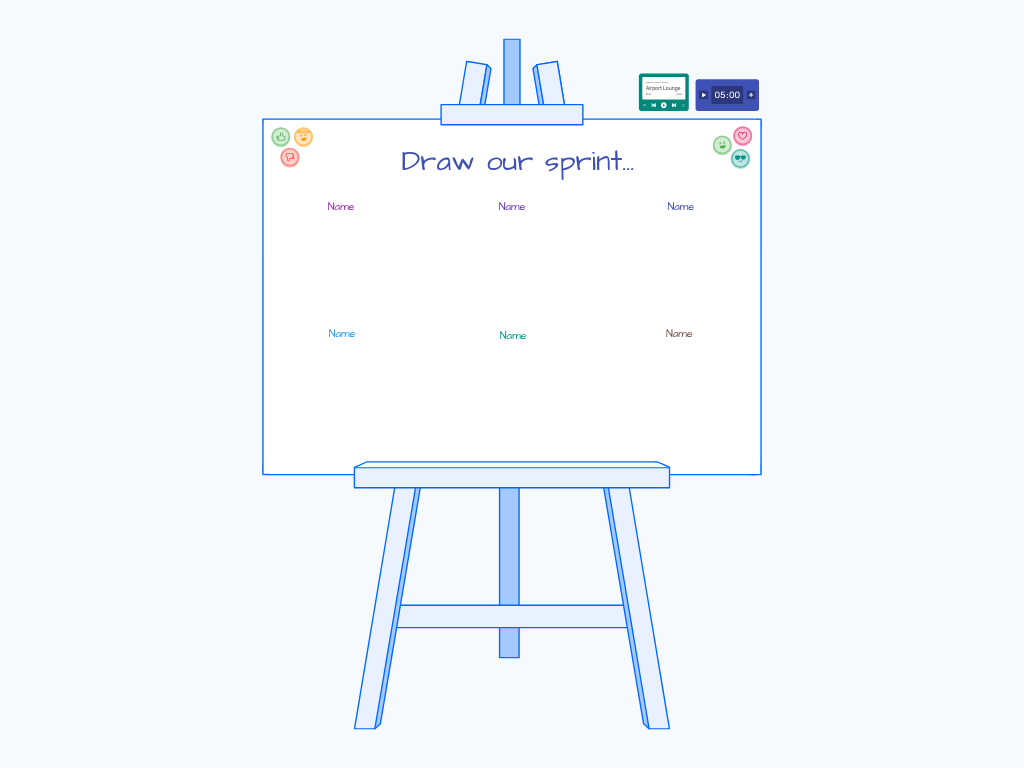Timeline Retro with Team Mood
Track sprint progress and team morale in one collaborative retrospective format. This dual-purpose template combines a visual timeline with mood tracking to help agile teams identify patterns between events and emotional responses throughout their sprint cycle.
What Is a Timeline Retrospective with Team Mood?
The Timeline Retrospective with Team Mood is a powerful agile retrospective technique that creates a chronological view of your sprint while monitoring the team's emotional state. Unlike standard retrospectives that focus solely on what happened, this template connects events to feelings, revealing how specific incidents affected team morale and productivity.
This approach uses a visual timeline across sprint days (typically 10 working days for a two-week sprint) with three key categories:
- Events: Notable occurrences during the sprint
- Good: Positive experiences or achievements
- Bad: Challenges, blockers, or disappointments
The unique mood tracker runs parallel to the timeline, allowing team members to plot their emotional state from elated (:-D) to furious (>:-() at different points in the sprint, creating a powerful emotional map of your iteration.
Benefits & When to Use
Use this template when:
- You suspect team morale might be affecting productivity
- You want to identify patterns between specific events and team sentiment
- Your team has completed a particularly challenging or successful sprint
- You need a more nuanced understanding of sprint dynamics than traditional retrospectives provide
Key benefits:
- Visualizes the entire sprint journey in chronological order
- Reveals correlations between events and emotional responses
- Helps identify which issues had the most significant impact on team morale
- Creates psychological safety by validating emotional responses to work events
- Provides deeper context for decision-making around process improvements
How to Run a Timeline Retro with Team Mood Session
Duration: 60-75 minutes for a team of 5-8 people
Set the Stage (5 min)
- Introduce the template structure and session goals
- Remind participants of the sprint goal for context
- Establish psychological safety by emphasizing there are no "wrong" feelings
Plot the Sprint Timeline (15-20 min)
- Ask team members to add sticky notes to the timeline showing:
- Yellow notes for significant events
- Green notes for positive experiences
- Red notes for challenges or difficulties
- Encourage everyone to include date references and specific details
- Ask team members to add sticky notes to the timeline showing:
Track Emotional Responses (10 min)
- Have each team member place mood tokens along the timeline
- Use the five-level scale from very happy (:-D) to very angry (>:-()
- Allow anonymous contributions for sensitive feedback
Analyze the Timeline Together (15-20 min)
- Walk through the timeline day by day as a group
- Identify patterns between events and mood shifts
- Discuss: "Were problems resolved? How did issues impact the team?"
- Look for correlations between mood dips and specific types of events
Generate Actionable Insights (15 min)
- Based on the timeline and mood analysis, brainstorm improvement ideas
- Vote on the top 3 actions to implement in the next sprint
- Assign owners to each action item
Tips for a Successful Session
- Pre-populate key events on the timeline before the session (sprint planning, demos, major releases) to provide structure
- Create psychological safety by contributing your own mood tokens first, showing vulnerability
- Watch for mood clusters - if multiple team members felt negative at the same time, prioritize addressing those triggers
- Look beyond individual events to identify systemic issues that affect morale over time
- Take screenshots of the completed timeline to reference in future retrospectives
- For remote teams, encourage participants to use their cameras when discussing emotional responses to build empathy
- Revisit the mood tracker in your next retrospective to see if implemented changes improved team sentiment
This retrospective format excels at uncovering the "why" behind sprint successes and challenges by connecting events with their emotional impact, leading to more targeted and effective process improvements.



